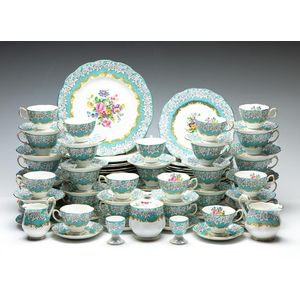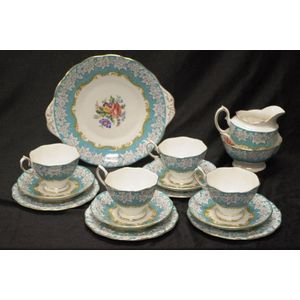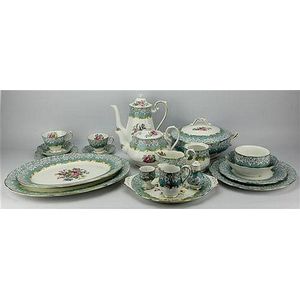
Enchantment Royal Albert Dinner/Tea Service
Royal Albert 'Enchantment' dinner/tea service comprising 9 teacups, 13 larger saucers, 11 medium saucers, 23 smaller saucers, 25 coffee cups, 21 small side plates, 18 bread plates, 18 dinner plates, 4 serving trays, 1 large sauce jug and saucer, 1 medium…

Royal Albert 'Enchantment' Teaset with 12 Pieces
Part Royal Albert 'Enchantment' teaset comprising 4 trios, a cake plate, a jug and sugar bowl

Royal Albert Cake Plates Set - Sweet Violets, Fragrance, Enchantment
Twelve Royal Albert cake plates including patterns 6 Sweet violets, 5 Fragrance, and 1 Enchantment, diameter 16.5 cm

'Enchantment' Royal Albert Tea Set with 6 Cups & Accessories
A Royal Albert 'Enchantment' tea service, includes six cups, a creamer & sugar bowl

Royal Albert Enchantment Tea Set
A Royal Albert 'Enchantment' tea service, includes six cups & saucers, a creamer & sugar bowl

Enchantment Tea Set with 19 Pieces
Royal Albert 'Enchantment' tea wares comprising fifteen cup saucer plate sets, another saucer & plate, a two handles cake plate, sugar bowl & cream jug.

Enchantment Teaset with Teapot by Royal Albert
Royal Albert Enchantment pattern teaset including Teapot

Royal Albert Enchantment Dinner Set
Royal Albert 'Enchantment' dinner setting comprising a lidded vegetable tureen, coffee pot, teapot, two platters, a cake plate, sugar bowl, (no lid), slops bowl, milk jug, creamer, salt & pepper shakers, twelve dinner plates, thirteen side plates, twelve…

 Loading more...
Loading more...